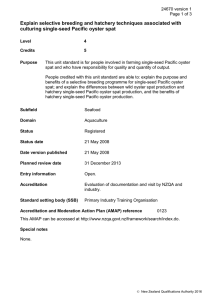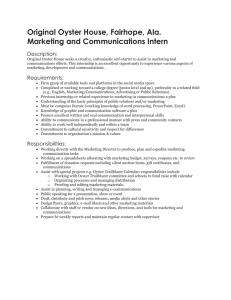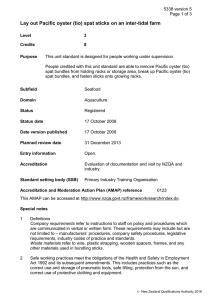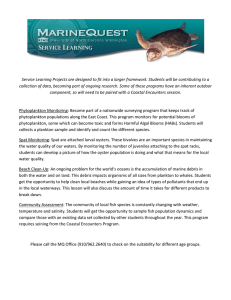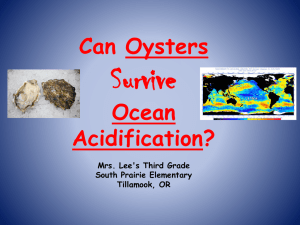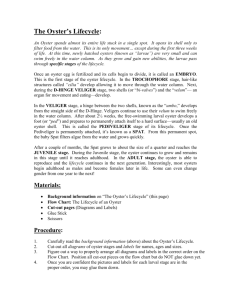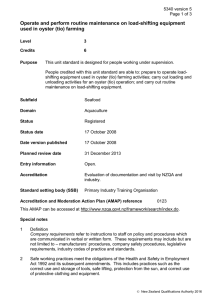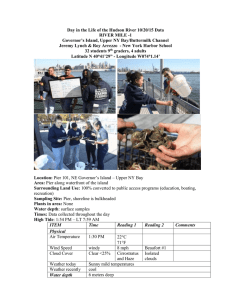Explain the growth of single-seed Pacific oyster spat in a... system, and handle the spat to maintain quality
advertisement
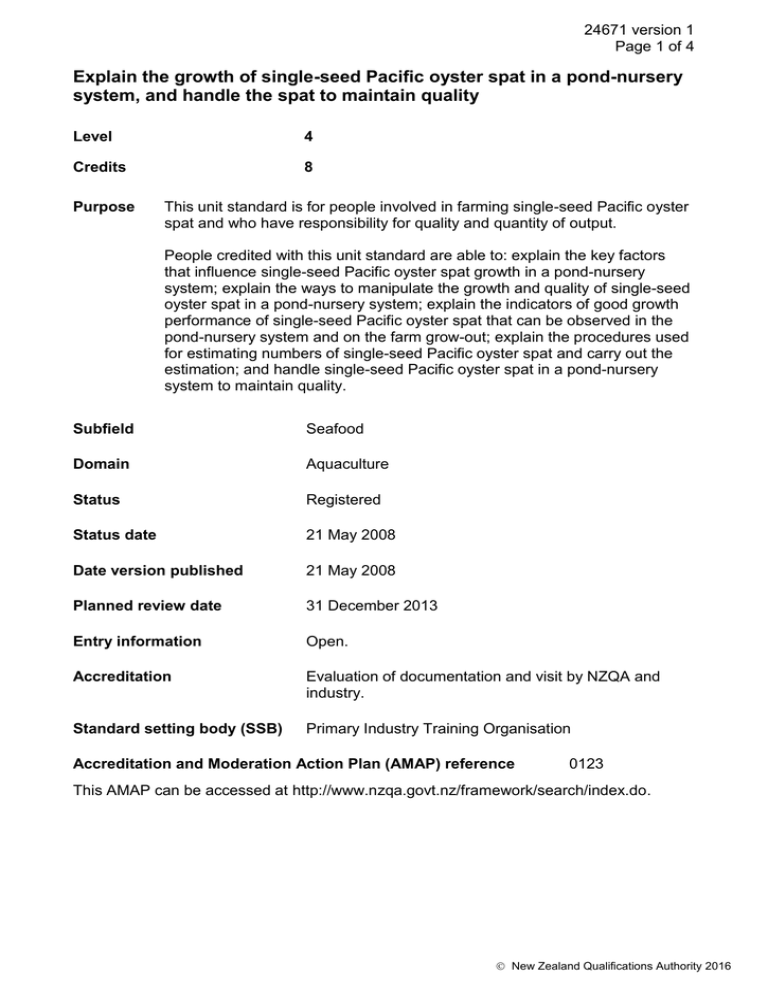
24671 version 1 Page 1 of 4 Explain the growth of single-seed Pacific oyster spat in a pond-nursery system, and handle the spat to maintain quality Level 4 Credits 8 Purpose This unit standard is for people involved in farming single-seed Pacific oyster spat and who have responsibility for quality and quantity of output. People credited with this unit standard are able to: explain the key factors that influence single-seed Pacific oyster spat growth in a pond-nursery system; explain the ways to manipulate the growth and quality of single-seed oyster spat in a pond-nursery system; explain the indicators of good growth performance of single-seed Pacific oyster spat that can be observed in the pond-nursery system and on the farm grow-out; explain the procedures used for estimating numbers of single-seed Pacific oyster spat and carry out the estimation; and handle single-seed Pacific oyster spat in a pond-nursery system to maintain quality. Subfield Seafood Domain Aquaculture Status Registered Status date 21 May 2008 Date version published 21 May 2008 Planned review date 31 December 2013 Entry information Open. Accreditation Evaluation of documentation and visit by NZQA and industry. Standard setting body (SSB) Primary Industry Training Organisation Accreditation and Moderation Action Plan (AMAP) reference 0123 This AMAP can be accessed at http://www.nzqa.govt.nz/framework/search/index.do. New Zealand Qualifications Authority 2016 24671 version 1 Page 2 of 4 Special notes Definition Company requirements refer to instructions to staff on policy and procedures that are communicated in an oral or written form. These requirements must include legislation and safety requirements and may include but are not limited to – manufacturers’ instructions, industry codes of practice and standards. Elements and performance criteria Element 1 Explain the key factors that influence single-seed Pacific oyster spat growth in a pondnursery system. Performance criteria 1.1 The explanation includes an outline of the environmental factors that influence single-seed Pacific oyster spat growth in a pond-nursery system. Range 1.2 water temperature, water quality, food availability. The explanation includes three management practices that can be used to manipulate the growth of single-seed Pacific oyster spat in a pond-nursery system. Range may include but is not limited to – stocking density, water flow, time in and out of water, handling, pond fertilisation. Element 2 Explain the ways to manipulate the growth and quality of single-seed oyster spat in a pond-nursery system. Performance criteria 2.1 The explanation includes the effect that the time the single-seed Pacific oyster spat is in and out of the water has on growth rate and quality of oyster spat. 2.2 The explanation includes the effect of pond fertilisation on single-seed Pacific oyster spat growth rate. New Zealand Qualifications Authority 2016 24671 version 1 Page 3 of 4 Element 3 Explain the indicators of good growth performance of single-seed Pacific oyster spat that can be observed in the pond-nursery system and on the farm grow-out. Performance criteria 3.1 The explanation includes the indicators of good growth performance of singleseed Pacific oyster spat that can be observed in the pond-nursery system and on the farm grow-out. Range evidence of two indicators is required. Element 4 Explain the procedures used for estimating numbers of single-seed Pacific oyster spat and carry out the estimation. Performance criteria 4.1 The procedure used for estimation of the number of single-seed Pacific oyster spat in the nursery is explained in accordance with company requirements. 4.2 The differences in requirements for estimating single-seed Pacific oyster spat numbers on the farm grow-out are explained in accordance with company requirements. 4.3 The factors that influence the precision of the estimate of single-seed Pacific oyster spat numbers are explained in accordance with company requirements. 4.4 The number of single-seed Pacific oyster spat in the nursery is estimated in accordance with company requirements. Element 5 Handle single-seed Pacific oyster spat in a pond-nursery system to maintain quality. Performance criteria 5.1 The quality of single-seed Pacific oyster spat in the pond-nursery system is maintained during handling in accordance with company requirements. Range includes but is not limited to – rumbling, grading, stocking, cleaning. Please note Providers must be accredited by the Qualifications Authority, or an inter-institutional body with delegated authority for quality assurance, before they can report credits from assessment against unit standards or deliver courses of study leading to that assessment. New Zealand Qualifications Authority 2016 24671 version 1 Page 4 of 4 Industry Training Organisations must be accredited by the Qualifications Authority before they can register credits from assessment against unit standards. Accredited providers and Industry Training Organisations assessing against unit standards must engage with the moderation system that applies to those standards. Accreditation requirements and an outline of the moderation system that applies to this standard are outlined in the Accreditation and Moderation Action Plan (AMAP). The AMAP also includes useful information about special requirements for organisations wishing to develop education and training programmes, such as minimum qualifications for tutors and assessors, and special resource requirements. Please note Providers must be accredited by NZQA, or an inter-institutional body with delegated authority for quality assurance, before they can report credits from assessment against unit standards or deliver courses of study leading to that assessment. Industry Training Organisations must be accredited by NZQA before they can register credits from assessment against unit standards. Accredited providers and Industry Training Organisations assessing against unit standards must engage with the moderation system that applies to those standards. Accreditation requirements and an outline of the moderation system that applies to this standard are outlined in the Accreditation and Moderation Action Plan (AMAP). The AMAP also includes useful information about special requirements for organisations wishing to develop education and training programmes, such as minimum qualifications for tutors and assessors, and special resource requirements. Comments on this unit standard Please contact the Primary Industry Training Organisation standards@primaryito.ac.nz if you wish to suggest changes to the content of this unit standard. New Zealand Qualifications Authority 2016
